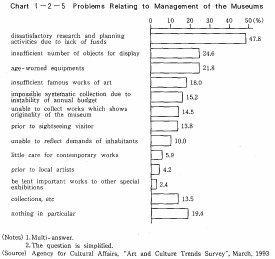| Home > Policy > White Paper, Notice, Announcement > White Paper > JAPANESE GOVERNMENT POLICIES IN EDUCATION, SCIENCE AND CULTURE 1993 > CHAPTER 2 �2 4 (2) | ||
Art museums, which collect, exhibit and preserve works of art, play an important role in the diffusion and promotion of art in local areas.
According to a Social Education Survey, as of October 1990, there were 91 public and 159 private art museums (registered museums or similar facilities that conform with the Museum Law) throughout Japan, for a total of 250 art museums. Compared with the figures for 1981 of 54 public and104 private museums for a total of 158 museums, this is a 1.6 fold increase over a period of ten years. Besides holding exhibitions in answer to local inhabitants' interest in art, many art museums also provide various informational and educational projects such as lectures, courses in practical art techniques and gallery talks.
According to the "Art and Culture Trends Survey", however, there are only an average of 2.9 qualified curators per museum. Although in-service training is occasionally conducted at 55.9 'No of museums. 39.8 % of the museums surveyed do not directly handle the matter of in-service training, but rather entrust it to the staff members themselves (Chart l-2-4). Concerning problems in the area of museum management, many museums reported "dissatisfactory research and planning activities due to lack of funds" and an "insufficient number of objects for display" (Chart I-2-5).
In endeavoring to offer yet richer opportunities for art appreciation to local inhabitants, the recruiting and training of qualified curators, the development of methods to systematically collect and display collections and the improvement of informational educational programs are all tasks that will need to be dealt with in the future. Therefore, it is important to refine the quality of museum curators by enriching their in-service training, to create a system that will provide information concerning their collections and activities and to form a mutual information network among art museums through collaboration between the central and local governments.
As a result of a decrease in the number of students due to a falling birth rate, the number of unused classrooms in elementary and secondary schools is increasing. It is necessary to consider the possibility of remodeling these into music halls, art museums or other types of cultural facilities, and to make them available to the public.


| Back to Top | MEXT HOME |